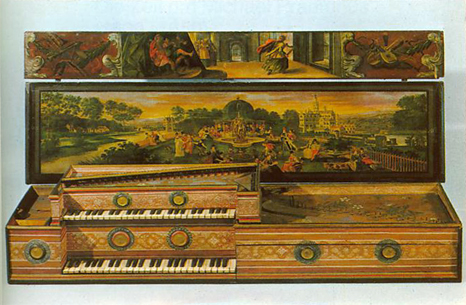The Virginal

"Mother and child", by Martinus van der Biest
Antverp 1580; Nürnberg, Germanisches Nationalmuseum
Particular to Flemish virginal makers were these literally "double" virginals: In a drawer in the case of an 8' virginal another 4' virginal was placed thus as to be played by two sitting aside each other but could also be placed atop the main manual and played together.
music sample:
(excerpt from Jan Pieterszoon Sweelinck: More Palatino
played by Gustav Leonhardt
Instrument: double virginal "mother and child" by Martinus van der Biest, Antverp 1580; Germanisches Nationalmuseum Nürnberg
Antverp was the centre of harpsichord making in Flandres, and there the Ruckers (later Couchet) family, active since 1579; in the 18th century the Dulcken family acquired similar fame.
One key element of Flemish harpsichord production was the multitude of different types. Besides the grands in different lengths (and therefore different pitches) with up to three stops. There were virginals available with Keyboard on or off-centre, to the left (to puzzle the posteriors called "Spinett") or to the right (called "Muselaar". Since these different placements also influenced the relation of the jacks in comparison to the strings (plucking rather central with a "muselaar", near the bridge with a "spinett") their sounds differed considerably. The "mother and child" instruments were another peculiarity, true "double" instruments to be played side by side, or atop of each other and coupled to be played as a 8'+4' instrument.
The outside of the instruments were often made of the light linden (Tilia) wood requiring rather thick walls, enabling to do without outer encasing (as opposed to Italian instruments), but nonetheless the instruments grew rather heavy to withstand string tension. The big mass took off a bit a promptness of attack but allowed an prolonged sustain which soon became an ideal for proper harpsichord sound. Therefore the Flemish instruments soon became models for harpsichord production in other countries (except Italy) and Flemish were exported in considerable numbers to France, England and other countries; one of the oldest instruments by Hans Ruckers from 1581 was discovered in Peru.
Flemish instruments were cared for, repeared, remodelled, and copied for centuries. Especially in France there were specialists for adapting Flemish harpsichords to the modernizing for clavecin music. Some English makers showed an ability in copying – one of the most famous English harpsichords (the "Ham house" harpsichord) appears to look like a Ruckers instrument of the 1630s but was made after 1700 in England.
Typical for Flemish instruments also was their decorative style, made to please the eye as well as the ear. Hardly any visible part or area was left undecorated and instrument makers and painters belonged to the same St Luke's guilds for more than a reason. So the famous Flemish and Dutch painters of interior genres, Vermeer among them, arise the suspicion that a virginal was an essential piece of furniture for a well sorted household of the 17th century.
© Greifenberger Institut für Musikinstrumentenkunde | info@greifenberger-institut.de



